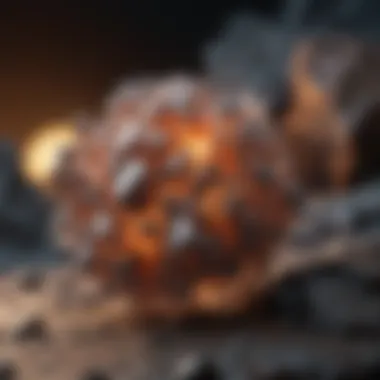Unveiling the Enigmatic World of Iron Rocks: Formation, Characteristics, and Significance


Rock and Fossil Identification
Iron rocks, with their rich history and geological significance, present a fascinating subject for enthusiasts and collectors. Exploring the types of iron-rich minerals and fossils found in these rocks provides a window into the Earth's ancient past. Key characteristics to look for include distinct colors, patterns, and crystalline structures that can aid in identification. Utilizing tools like magnifying glasses, streak plates, and hardness picks is essential for a thorough examination and classification of iron rocks.
Collecting Tips and Techniques
When it comes to collecting iron rocks, adhering to best practices is crucial to preserving the specimens and their context. Locating prime collecting sites often involves research and knowledge of geological formations conducive to iron mineralization. To safely extract specimens, tools like rock hammers, chisels, and gloves are recommended to minimize damage and ensure personal safety.
Preservation and Display
Preserving iron rocks requires careful techniques to maintain their integrity over time. Proper storage methods include storing specimens in acid-free containers with padding to prevent scratching. Creative display ideas can enhance the aesthetic appeal of the collection, such as using shadow boxes, custom stands, or incorporating lighting to highlight the unique features of each specimen.
Geological Insights
Delving into the geological insights offered by iron rocks unveils their role in the Earth's history. Understanding the processes that led to the formation of these rocks provides valuable insight into ancient environments and mineral deposition. The historical significance of iron-rich minerals in geology is underscored by notable discoveries that have shaped our understanding of how these rocks contribute to the broader field of earth sciences.
Geological Significance of Iron Rocks
The geological significance of iron rocks transcends mere mineral exploration, encompassing broader themes of economic significance, environmental impact, and historical legacy. By delving into the world of iron ores and banded iron formations, we unveil the intricate relationships between geological processes, mineralization mechanisms, and industrial practices, offering a holistic perspective on the role of iron rocks in shaping the Earth's crust.
Iron Ores and Mining Industry
Iron ores constitute a cornerstone of the global mining industry, serving as a primary source of iron for steel production, metallurgical processes, and industrial applications. The economic value of iron ores lies in their high iron content, low impurities, and favorable extraction characteristics, making them essential commodities in modern society. Understanding the geological distribution and mineralogical features of iron ores is vital for optimizing mining operations, resource management, and sustainable development practices.
Formation of Banded Iron Formations
Banded iron formations (BIFs) represent a unique geological assemblage characterized by alternating layers of iron-rich minerals and silica-rich cherts. The formation of BIFs offers a window into the early Earth's environment, where the interplay of volcanic activity, ocean chemistry, and biological processes resulted in massive deposits of iron and silica. Studying the stratigraphy and geochemistry of BIFs provides valuable clues to Earth's evolutionary history, paleoenvironmental conditions, and mineral precipitation mechanisms, offering a rich tapestry of geological insights into the origins of iron-rich rocks.
Characteristics of Iron Rocks
In the realm of geology, understanding the characteristics of iron rocks plays a pivotal role in unraveling the mysteries that shroud these fascinating formations. The exploration of iron rocks delves beyond their mere physical appearance, delving into a realm where density, hardness, magnetic properties, and chemical composition intertwine to create a tapestry of uniqueness and importance.
Physical Properties
Density and Hardness:
Density and hardness serve as fundamental pillars in deciphering the essence of iron rocks. The density of iron rocks, defined by the mass per unit volume, provides crucial insights into their structural integrity and potential uses. Hardness, on the other hand, determines the resistance of iron rocks to deformation and scratching, revealing their durability and resilience against external forces. The interplay between density and hardness is what makes iron rocks a standout feature in the geological landscape, offering a blend of robustness and stability that underpins their significance in this article. The unique feature of density and hardness lies in their ability to withstand extreme conditions, making them a preferred choice for detailed analyses and practical applications within the realm of iron rocks. While the advantages of high density and hardness include durability and long-term preservation, a notable disadvantage may lie in the challenges posed during extraction and processing within the scope of this article.
Magnetic Properties:
Magnetic properties serve as a distinguishing factor for iron rocks, adding a layer of intrigue to their overall allure. The magnetic nature of certain iron rocks can be attributed to their mineral composition, primarily influenced by the presence of magnetite. This inherent magnetic quality not only aids in the identification of iron-rich specimens but also opens avenues for exploration in magnetic technologies. The key characteristic of magnetic properties lies in their responsiveness to magnetic fields, a trait that allows for various scientific and industrial applications within the context of this article. The unique feature of magnetic properties bridges the gap between geological fascination and technological advancement, offering a symbiotic relationship that amplifies the value of iron rocks. While the advantages of magnetic properties lie in their utility for innovative research and technological developments, potential disadvantages may arise in specific geological contexts, requiring careful consideration within this article.
Chemical Composition
Iron Content Variations:


Iron content variations serve as a cornerstone in defining the composition and quality of iron rocks, shaping their overall characteristics and usability. The fluctuation in iron concentrations within different specimens not only influences their physical properties but also contributes to diverse visual attributes. The key characteristic of iron content variations lies in their capacity to determine the grade and purity of iron rocks, a critical aspect in distinguishing between different geological formations. This unique feature of iron content variations plays a vital role in resource assessment and exploration strategies, offering valuable data for researchers and collectors alike within the scope of this article. While the advantages of varied iron content include versatility and distinct appearances, potential disadvantages may stem from challenges in extraction and processing associated with differing iron concentrations.
Impurities and Alloying Elements:
Impurities and alloying elements introduce a layer of complexity to the chemical composition of iron rocks, shaping their overall properties and functionalities. The presence of impurities, such as sulfur or phosphorus, can impact the structural integrity and behavior of iron rocks, influencing factors like strength and corrosion resistance. Alloying elements, on the other hand, enhance specific characteristics of iron rocks, such as enhancing hardness or improving machinability. The key characteristic of impurities and alloying elements lies in their ability to modify the properties of iron rocks, offering a means to tailor their attributes for specific applications. This unique feature of impurities and alloying elements sparks innovation and experimentation in the utilization of iron rocks, driving advancements in both industrial and artistic domains within this article. While the advantages of controlled impurities and strategic alloying include customization and improved performance, potential disadvantages may arise from the complex processing requirements and environmental considerations within this article.
Visual Appearance
Color Spectrum:
The color spectrum of iron rocks unveils a visual feast for enthusiasts and researchers, showcasing a plethora of hues and tones that reflect their mineralogical composition and environmental history. From deep reds of hematite to the silvery sheen of magnetite, the color spectrum serves as a visual signature that distinguishes iron-rich minerals. The key characteristic of the color spectrum lies in its ability to convey the geological origins and mineral content of iron rocks, providing valuable cues for identification and classification. This unique feature of the color spectrum offers a gateway into the vibrant world of mineral diversity, inviting exploration and admiration for its kaleidoscopic array. While the advantages of diverse coloration include aesthetic appeal and scientific insights, potential disadvantages may arise in instances where color variations complicate mineral categorization and interpretation within this article.
Surface Texture:
The surface texture of iron rocks represents a tactile dimension that complements their visual allure, offering a tactile experience that reveals insights into their formation and history. The varied textures, ranging from smooth to rough, crystalline to granular, reflect the geological processes that shaped these magnificent specimens. The key characteristic of surface texture lies in its ability to convey the environmental conditions and mineralogical interactions that influenced the development of iron rocks, enriching the narrative of their discovery and significance. This unique feature of surface texture enhances the sensory engagement with iron rocks, inviting tactile exploration and tactile evaluation of their unique attributes. While the advantages of diverse surface textures include tactile appreciation and contextual understanding, potential disadvantages may arise in instances where intricate textures pose challenges for preservation and documentation within this article.
Uses and Applications of Iron Rocks
Iron rocks play a crucial role in various industries and applications, making them a significant subject of study and fascination within the geology realm. In this article section on the Uses and Applications of Iron Rocks, we will delve into the diverse range of purposes these rocks serve, their importance, and key considerations for enthusiasts and collectors.
Industrial Utilization
Iron Smelting and Steel Production
Iron smelting and steel production represent a cornerstone of the iron industry, contributing significantly to the manufacturing of essential materials worldwide. The process of iron smelting involves extracting iron from its ores through heating at high temperatures, resulting in the production of steel. The key characteristic of iron smelting lies in its ability to transform raw iron ores into durable and versatile steel products. This aspect is crucial in various sectors such as construction, automotive, and infrastructure development. Despite its energy-intensive nature, iron smelting offers unparalleled strength and durability, making it a preferred choice for meeting the growing global demand for steel products. The unique feature of iron smelting lies in its role in shaping modern civilization through the creation of robust structures and tools. However, challenges such as environmental concerns and carbon emissions warrant innovative solutions to enhance sustainability in iron smelting processes.
Magnetism and Technology
The utilization of iron rocks in magnetism and technology showcases their adaptability and versatility in cutting-edge innovations. Iron's magnetic properties make it invaluable in various technological applications, including electromagnets, electric motors, and data storage devices. The key characteristic of iron's magnetism lies in its ability to be magnetized and demagnetized repeatedly, ensuring reliability and efficiency in diverse technologies. This feature makes iron a popular choice for magnetic components due to its affordability and abundance. The unique feature of iron's magnetism lies in its fundamental role in enabling advanced technological advancements that drive modern societies. However, challenges such as material efficiency and technological optimization continue to shape the evolution of iron's magnetism in technology, prompting research into sustainable practices and enhanced performance.
Historical Importance
Iron Age Discoveries
The archaeological significance of iron age discoveries underscores the pivotal role of iron rocks in shaping ancient civilizations and human progress. Iron age discoveries mark a transformative period in human history, marking the transition from the bronze age to the iron age. The key characteristic of iron age discoveries lies in their impact on metalworking techniques and tool innovation, revolutionizing ancient societies' productivity and capabilities. This aspect is beneficial as it highlights the technological advancements and cultural shifts facilitated by iron age discoveries, paving the way for significant civilizations and empires to thrive. The unique feature of iron age discoveries lies in their enduring legacy, evident in artifacts and monuments that testify to humanity's ingenuity and advancements in metallurgy. However, challenges such as conservation and preservation efforts underscore the importance of safeguarding these historical relics for future generations and scholarly research.
Cultural Significance
The cultural significance of iron rocks transcends mere material value, encompassing symbolic and aesthetic dimensions that enrich societies and artistic expressions. Iron's cultural importance has been intertwined with rituals, beliefs, and artistic endeavors across diverse cultures and epochs. The key characteristic of iron's cultural significance lies in its association with strength, endurance, and innovation, symbolizing human resilience and creativity. This aspect is beneficial as it fosters a deeper appreciation for iron's historical and cultural relevance, bridging past traditions with contemporary interpretations. The unique feature of iron's cultural significance lies in its ability to inspire artistic masterpieces and architectural marvels that reflect society's ethos and aspirations. However, challenges such as changing perceptions and conservation ethics underscore the need to balance preserving cultural heritage with embracing modern interpretations of iron in cultural practices.
Artistic and Decorative Use
Sculptures and Artifacts
The artistic exploration of iron rocks in sculptures and artifacts showcases their malleability and expressive potential in creating aesthetic marvels. Sculptures and artifacts crafted from iron bear testimony to human creativity and craftsmanship, embodying diverse themes and narratives. The key characteristic of iron sculptures lies in their durability and malleability, allowing artists to realize intricate designs and forms that captivate viewers. This aspect is beneficial as it preserves historical and artistic legacies, offering insights into societal values and cultural aesthetics through iron artworks. The unique feature of iron sculptures lies in their ability to evoke emotions and provoke reflections on human experiences and societal themes through the tactile and visual qualities of the medium. However, challenges such as maintenance and conservation practices pose considerations for preserving iron sculptures and artifacts for future generations, necessitating strategic approaches for long-term care and appreciation.
Interior Design Elements


The integration of iron rocks as interior design elements elevates spaces with their distinctive texture, color, and industrial charm. Interior design elements incorporating iron materials bring a sense of rugged elegance and functional aesthetics to various settings. The key characteristic of iron in interior design lies in its versatility and compatibility with diverse design styles, ranging from minimalist to rustic chic. This aspect is beneficial as it creates a unique spatial experience and adds visual interest and depth to interiors, fostering a sense of character and timelessness. The unique feature of iron interior design elements lies in their ability to infuse spaces with a touch of authenticity and historical narrative, establishing connections between past heritage and contemporary lifestyles. However, challenges such as maintenance and design synergy require careful attention to harmonizing iron elements with complementary materials and textures, ensuring a cohesive and balanced interior design scheme.
This detailed exploration of the uses and applications of iron rocks underscores their multifaceted contributions to industrial, historical, cultural, and artistic domains, enriching our appreciation for these remarkable geological treasures.
Preserving and Collecting Iron Rocks
Storage and Maintenance
Ideal Conditions for Preservation
Ideal conditions for preserving iron rocks play a pivotal role in maintaining their structural integrity and visual appeal. Optimal storage areas with controlled humidity and temperature help prevent degradation and ensure the longevity of the specimens. By implementing these ideal conditions, collectors can safeguard the quality and authenticity of their iron rocks, enhancing their value and appeal in the long run. The unique feature of ideal preservation conditions is their ability to mimic natural environments, creating a stable setting for the rocks to exist without succumbing to external factors such as corrosion or environmental damage.
Preventing Oxidation
Preventing oxidation is a key consideration when preserving iron rocks, as exposure to oxygen can lead to rusting and deterioration of the specimens. Implementing techniques such as using desiccants or airtight containers helps shield the rocks from oxidation, preserving their appearance and structural composition. While oxidation is a natural process for iron-containing materials, preventive measures can significantly slow down this degradation, maintaining the aesthetic and scientific value of the specimens over time.
Collection Strategies
Categorization and Labeling
Categorizing and labeling iron rocks is essential for cataloging and organizing collections efficiently. By clearly classifying specimens based on their geological characteristics and origins, collectors can easily locate and study specific pieces within their assortment. This systematic approach not only streamlines the collection process but also enhances the overall presentation and accessibility of the iron rocks. The unique feature of categorization and labeling is its ability to provide a structured framework for collectors to expand their knowledge and appreciation of different iron formations.
Ethical Sourcing Practices
Ethical sourcing practices are integral to collecting iron rocks responsibly and sustainably. By ensuring that specimens are acquired through legal and environmentally conscious means, collectors contribute to the preservation of natural resources and eliminate the risk of supporting illicit activities. Ethical sourcing also involves obtaining rocks from reputable sources that adhere to fair labor practices and conservation guidelines. This practice not only protects the integrity of collections but also upholds ethical standards within the geological community, promoting transparency and integrity.
Professional Conservation Techniques
Restoration Processes
Restoration processes are essential for preserving and enhancing the aesthetic appeal of iron rocks that may have undergone damage or deterioration over time. By employing specialized techniques such as cleaning, repair, and stabilization, collectors can revitalize old or damaged specimens, restoring them to their former glory. The key characteristic of restoration processes lies in their ability to balance conservation with aesthetic enhancement, breathing new life into treasured iron rock specimens. While restoration can rejuvenate rocks for display and study, it requires careful consideration to maintain authenticity and integrity.
Display and Exhibition Tips
Display and exhibition tips offer collectors insights into showcasing their iron rock collections effectively to maximize impact and engagement. By strategically arranging specimens based on size, shape, and color, collectors can create visually appealing displays that highlight the unique features of each rock. Utilizing proper lighting, mounts, and information cards further enhances the exhibition experience for viewers, providing educational context and aesthetic enjoyment. The unique feature of display and exhibition tips is their ability to transform collections into captivating exhibitions that not only inform but also inspire curiosity and appreciation among audiences.
Exploring Iron Rocks in Nature
Volcanic Environments
Exploring iron rocks in volcanic environments unveils a unique aspect of their formation and characteristics. The key characteristic that distinguishes volcanic environments is the intense thermal energy and pressure conditions under which iron-rich minerals crystallize and solidify. This process results in distinctive textures and composition that are beneficial for this article in illustrating the diverse origins of iron rocks. The advantage of volcanic environments lies in their ability to produce varied forms of iron-rich minerals, showcasing the rich diversity within the realm of iron geology.
Sedimentary Deposits
The exploration of iron rocks in sedimentary deposits reveals a contrasting yet equally significant aspect of their genesis. Sedimentary deposits represent environments where iron minerals accumulate over time through sedimentation and precipitation processes. The key characteristic of sedimentary deposits is the layering and gradual accumulation of iron-rich sediments, reflecting prolonged geological processes. This choice is beneficial for the article as it showcases the different geological settings in which iron rocks can be found. The advantage of sedimentary deposits lies in their potential to preserve well-defined layers of iron-rich minerals, offering valuable insights into Earth's history.


Global Distribution
Understanding the global distribution of iron-rich deposits plays a crucial role in appreciating the widespread occurrence of these geological treasures. By exploring the hotspots of iron-rich deposits, readers embark on a journey to key regions known for their abundance of iron-bearing minerals. Highlighting the unique features of these hotspots emphasizes their geological significance and relevance to this article. The advantages of studying hotspots of iron-rich deposits lie in gaining a comprehensive view of the diversity and concentration of iron rocks across different geographical locations.
Geological Landmarks
The exploration of iron rocks through geological landmarks provides a systemic approach to mapping out significant sites where unique iron formations are present. By focusing on specific geographical features that showcase exceptional iron-rich deposits, readers can grasp the geological processes that have shaped these landscapes. The key characteristic of geological landmarks is their ability to serve as reference points for studying the formation and evolution of iron rocks, making them a valuable choice for this article. The unique feature of geological landmarks lies in their rich mineralogical diversity and the potential they hold for unraveling complex geological histories.
Field Guide for Collectors
The section dedicated to a field guide for collectors offers practical insights into identifying iron-rich specimens and adopting safe exploration practices. By highlighting methods for distinguishing various types of iron rocks and promoting responsible collection techniques, this segment equips enthusiasts with the necessary tools for engaging with these geological wonders.
Identifying Iron-Rich Specimens
The aspect of identifying iron-rich specimens provides collectors with essential knowledge on recognizing key features that differentiate one mineral from another. By emphasizing the distinct characteristics of magnetite, hematite, siderite, and other iron-rich minerals, readers can refine their identification skills. This choice is beneficial for the article as it encourages a deeper understanding of the visual and chemical attributes that define different iron rocks. The advantage of focusing on identifying iron-rich specimens lies in enabling collectors to build a comprehensive collection based on diverse mineral compositions and structures.
Safe Exploration Practices
Discussing safe exploration practices guides collectors on how to conduct their fieldwork responsibly while minimizing environmental impact. By emphasizing safety measures such as obtaining permits, avoiding sensitive ecosystems, and respecting land regulations, this aspect ensures that collectors engage in ethical and sustainable exploration. The choice to highlight safe exploration practices aligns with the goals of this article by promoting the preservation of natural habitats and fostering a positive relationship between collectors and the environment. The advantage of incorporating safe exploration practices lies in fostering a culture of conservation and respect for the natural world among enthusiasts and collectors.
Future Prospects and Innovations
In this article, the section on Future Prospects and Innovations plays a pivotal role in shedding light on the anticipated advancements within the realm of iron rocks. It offers a glimpse into the potential transformations and novel developments that could revolutionize the study and utilization of iron-rich minerals. By focusing on futuristic possibilities, this segment aims to propel readers into the cutting edge of research and innovation in the field of iron geology. This section acts as a bridge between the historical significance of iron rocks and the promising prospects that lie ahead, making it a crucial point of interest for enthusiasts and professionals alike.
Advanced Research in Iron Geology
Nanotechnology Applications
Nanotechnology Applications signify a groundbreaking leap in the application of nanoscience to manipulate and enhance the properties of iron-rich minerals. This aspect aligns perfectly with the theme of innovation and advancement in iron geology as nanotechnology offers unprecedented control over the composition and structure of these minerals. The key characteristic that sets Nanotechnology Applications apart is their ability to operate at the atomic and molecular levels, allowing for precise modifications and tailored improvements in various aspects of iron rock utilization. While the unique feature of Nanotechnology Applications lies in their capability to optimize the efficiency and functionality of iron rocks, there are inherent challenges related to ethical considerations and the potential ecological impact that must be carefully addressed in this context.
Eco-Friendly Mining Practices
Within the landscape of mining practices, Eco-Friendly Mining stands out as a beacon of sustainability and environmental consciousness. Its key characteristic lies in the prioritization of minimizing the ecological footprint and mitigating the adverse effects traditionally associated with mining operations, specifically in the realm of iron geology. The unique feature of Eco-Friendly Mining Practices incorporates elements such as renewable energy integration, waste reduction strategies, and ecosystem restoration efforts, making it a favorable choice for sustainable iron rock extraction. While the advantages of Eco-Friendly Mining Practices are evident in promoting environmental stewardship and long-term resource viability, challenges related to operational costs and technological integration need to be navigated effectively within the context of this article.
Technological Advancements
Automation in Mining Operations
The integration of Automation in Mining Operations represents a significant shift towards efficiency and precision in the extraction and processing of iron-rich minerals. Its key characteristic revolves around the advanced machinery and algorithms employed to streamline and optimize the entire mining workflow, resulting in enhanced productivity and safety measures. Automation in Mining emerges as a popular choice for this article due to its potential to revolutionize traditional mining practices, offering benefits such as reduced human error, increased output capacities, and a safer working environment. The unique feature of Automation in Mining lies in its ability to operate continuously, 24/7, with minimal downtime, leading to significant gains in operational efficiency. However, challenges related to technological limitations and workforce reskilling requirements should be considered when exploring the implications of Automation in Mining Operations within the context of iron geology.
Digital Mapping Solutions
The deployment of Digital Mapping Solutions unveils a new era of precision and accuracy in the exploration and visualization of iron-rich deposits and geological formations. The key characteristic of Digital Mapping Solutions lies in their use of cutting-edge technologies, such as Geographic Information Systems (GIS) and LiDAR (Light Detection and Ranging), to create comprehensive 3D models and spatial analyses of iron rock landscapes. This innovative approach proves to be beneficial for this article as it enhances the understanding of geographical features, resource mapping, and identification of potential mining sites with unprecedented detail and clarity. The unique feature of Digital Mapping Solutions is their capacity to integrate real-time data and remote sensing techniques, thereby facilitating informed decision-making processes for stakeholders involved in iron geology. Despite its advantages in enhancing geological mapping accuracy and efficiency, challenges related to data security and maintenance costs need to be addressed to harness the full potential of Digital Mapping Solutions within the context of this article.
Environmental Sustainability
Recycling and Circular Economy Initiatives
The emphasis on Recycling and Circular Economy Initiatives underscores a paradigm shift towards sustainable resource management and waste reduction strategies within the domain of iron rock utilization. Its key characteristic lies in the promotion of closed-loop systems that aim to maximize the reuse, recycling, and repurposing of iron-rich materials to minimize environmental impact and resource depletion. This aspect resonates strongly within this article as it advocates for a holistic approach to iron rock conservation and responsible consumption practices. The unique feature of Recycling and Circular Economy Initiatives lies in their potential to create a self-sustaining ecosystem where waste is minimized, and resources are utilized efficiently, leading to environmental benefits and long-term economic advantages. Despite its clear advantages in promoting resource efficiency and reducing landfills, challenges related to infrastructure development and market demand dynamics pose significant considerations that need to be addressed within the framework of this article.
Mitigating Ecological Impact
The focus on Mitigating Ecological Impact spotlights the critical importance of safeguarding natural ecosystems and biodiversity while engaging in iron rock exploration and extraction activities. Its key characteristic revolves around implementing practices and technologies that reduce the environmental harm associated with mining operations, such as soil erosion, water contamination, and habitat destruction. This aspect aligns perfectly with the overarching theme of environmental sustainability within this article, emphasizing the need for proactive measures to mitigate ecological impact and preserve ecological balance in iron-rich environments. The unique feature of Mitigating Ecological Impact lies in its potential to foster responsible stewardship of natural resources and promote conservation efforts that benefit both the environment and local communities. Despite its positive implications for environmental protection and stakeholder engagement, challenges related to regulatory compliance and monitoring protocols need to be diligently addressed to ensure effective mitigation of ecological impact within the context of this article.







